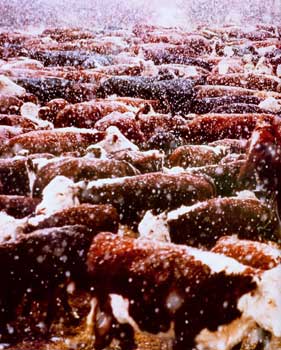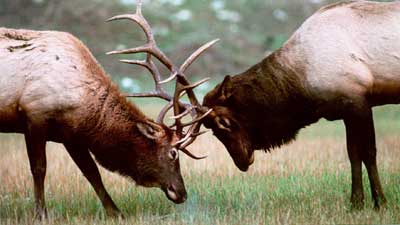Alberta: Wild Rose Country
A Land of
Shining Mountains. Love
at First Sight.
An Article
written by David Kilgour
which appears in
"Canada: The
New Millennium Series."

Malak's
famous photo of a cattle
drive on the Canadian prairie
in early Spring has won
many awards.
It
is always difficult to provide
a short but adequate flavour
to one’s home province in
the complex Canadian federation.
This is particularly true
with regard to Alberta,
a country-sized area with
seven distinct regions and
whose residents are of origin
in virtually every member
state of the United Nations.
Until
recently, most of the world
seemed to notice only our
Rocky Mountains, rolling
foothills, and glacier-fed
rivers and lakes. Banff
and Jasper National Parks
are, of course, difficult
for anyone, including other
Canadians, to ignore when
contemplating Alberta.
But
what of the province’s half
dozen modern cities, of
which Edmonton, our provincial
capital and home to many
festivals, and Calgary,
the business head office
magnet, compete in numerous
fields? The fierce, yet
fun-filled competition includes
population growth (both
metropolitan centres have
approximately one million),
cultural life (symphony
orchestras, ballet, art,
opera, theatre) universities
and colleges and sports
(track & field, hockey,
football, soccer, basketball
and baseball).

The
American Elk - The Shawnee
Indians referred to this
large deer (which can weigh
up to 800 pounds) as waptiti
or "white rump." It is the
nosiest deer in Canada and
during the mating season
the males' bugle cry can
carry for up to a mile.
During
the Calgary Stampede and
Edmonton Klondike Days,
thousands of volunteers
dress in period costumes
and relive earlier days
to the delight of visitors
and themselves. Yet it is
the modern Albertan themselves
who year round make the
province the formidable
national force it is today.
Our
First Nations peoples probably
arrived thousands of years
ago from Asia and succeed
in establishing rich cultural
and family lives in numerous
communities, including the
Blackfoot and Cree Nations.
Later in the late nineteenth
century, when an estimated
sixty million buffalo were
slaughtered mostly for ‘sport’
by outsiders, their way
of life disappeared and
painful decades of adjustment
began.
In
the first decades of the
twentieth century, pioneer
families from almost everywhere
on earth arrived in Prairie
Canada (which was know as
the last, best West) to
break land for crops and
to build local churches
of many faith and communities.
In 1947, however, this settlement
period changed substantively
when oil was discovered
near Edmonton. For example,
the population of each province
on the prairies was about
750,000; today Alberta has
slightly more than three
times the population of
each of our two sister provinces
(three million vs. one million).
Thousands
of us work directly in the
oil and gas sector, but
far more earn livelihoods
in related fields such as
pipeline construction and
software design. The immense
wealth created by oil (“black
gold”) and more recently
by the relative pollution-free
natural gas, has allowed
our schools and 29 or so
post-secondary educational
institutions to flourish.
Our publicly run health-care
system, highways and social
programs are also among
Canada’s best. Many Albertans
today know that abundant
natural resources, unless
handled with prudence and
self-discipline, can prove
to be a curse.
I
think the really fascinating
feature of the province
is our unique cultural mosaic;
a consequence partly of
the reality that no ethno-cultural
group is numerically dominant.
Members of every community,
including the larger ones
(English, Scottish, Irish,
First Nations, Chinese and
French Canadian), believe
that individuals are of
equal worth and should have
the freedom to choose their
own lifestyle. A pattern
of permissive differentiation
in religion, language and
culture, instead of assimilation
emerged quite early in the
province. Following some
bitter experiences with
prejudice and discrimination,
a truly international society
with a habit of inclusiveness
developed in Alberta.
Next Page
|
